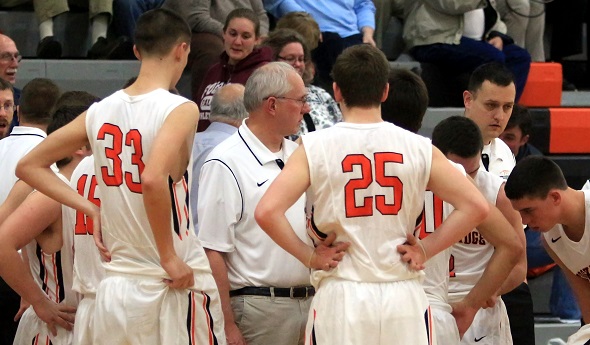
As Stockbridge Learns, Swoverland Earns 400
January 28, 2016
By Geoff Kimmerly
Second Half editor
STOCKBRIDGE – The new coach had won a lot of games. He must know what he’s doing, Mason Gee-Montgomery figured.
 And that’s all he knew about Randy Swoverland when the latter took over Stockbridge’s boys basketball program two years ago.
And that’s all he knew about Randy Swoverland when the latter took over Stockbridge’s boys basketball program two years ago.
But by the end of their first summer workout, Gee-Montgomery realized how hard the Panthers would be working that winter. And although the team finished only 8-13 that first season of 2014-15 (solid, actually, considering the team returned only one player with varsity experience), the now-junior point guard recognized his coach was putting the team in position to win – as long as he and his teammates held to what Swoverland was teaching them, and despite the fact some classmates didn’t stick around to help.
“It’s definitely a lot different than any coach we’ve had,” Gee-Montgomery said. “He takes the intensity to another level, and he expects things done a certain way. And if you don’t get them done that way, he’ll let you know.
“He definitely holds us accountable for the way we play, and I think that style of coaching suits the team we have because we hold each other accountable and he holds us accountable for ourselves. It just makes us play at another level.”
He could’ve been speaking for many of the teams Swoverland has led over the last four decades. And many of those players have been on the coach’s mind since his 400th career win Jan. 19, a 49-47 Stockbridge victory over Lansing Christian.
Swoverland has coached basketball at nine high schools over 37 years, building a record of 402-332. He also coached two seasons of boys and girls tennis, three of football and two seasons of men’s basketball at Adrian College since starting his coaching career in the fall of 1977 at Greenville High.
“When I got the win, I was happy. My guys were excited for me. But I also think back to all of the guys I coached in the 70s, 80s, 90s; they’re as much a part of it as what we’re certainly doing right now,” Swoverland said. “My thoughts and memories go all the way back to all of those teams.”
Although most in his new school’s community probably weren’t familiar with the past successes, Swoverland wasn’t exactly a stranger in a strange land when he picked up the milestone win on his newest team’s home court – Stockbridge is only 17 miles from Dexter, where he lives, has a son in high school and led teams to 245 of those victories.
He certainly has left an imprint on communities all over the Lower Peninsula and Ohio border, with 11 stops combined at those nine high schools and one college.
Stops along the way
Swoverland coached boys and girls tennis and also served as a boys basketball assistant at Greenville after finishing a four-year basketball career at Adrian College, where he was a captain as a senior. After Greenville came his first head coaching job, for a season at Edmore (now Blanchard) Montabella. He spent 1979-80 coaching Deckerville’s boys before heading back to Adrian College as an assistant men’s basketball coach; the head coach got fired and he lost his job there two years in. At the same time, Swoverland had been teaching and coaching football at Evergreen High School in Metamora, Ohio, and took over the girls basketball program there for one season. (He taught mathematics for 38 years total, retiring from the classroom after the 2013-14 school year.)
 Swoverland moved on to coach Hudson’s boys basketball varsity from 1983-91, leading the Tigers to a league championship in 1989, a District title in 1991 and a 102-72 record. Then came his first tenure at Dexter from 1992-2001 – his teams finished a combined 131-90 with four league and four District titles and posted a 22-2 record in 1997-98. A need for something new led him to Adrian High School for three seasons from 2002-04 – and realizing Dexter was a better fit led him back to coach the Dreadnaughts from 2005-13, during which time they finished 114-90 and won two District titles.
Swoverland moved on to coach Hudson’s boys basketball varsity from 1983-91, leading the Tigers to a league championship in 1989, a District title in 1991 and a 102-72 record. Then came his first tenure at Dexter from 1992-2001 – his teams finished a combined 131-90 with four league and four District titles and posted a 22-2 record in 1997-98. A need for something new led him to Adrian High School for three seasons from 2002-04 – and realizing Dexter was a better fit led him back to coach the Dreadnaughts from 2005-13, during which time they finished 114-90 and won two District titles.
Swoverland then took 2013-14 off from coaching – and missed it too much. He applied for and received the Stockbridge job that spring, taking over for Joe Wenzel, who also was the school’s athletic director and had coached in the district 11 seasons and the varsity during his last two.
The Panthers finished last winter with four losses over their final five games, but a combined eight points from finishing 12-9 instead. They also handed one of only two league losses to eventual Greater Lansing Activities Conference champion Lake Odessa Lakewood. This winter, the varsity has only nine players – but also nine wins, off to a 9-2 start and tied for second in the GLAC with a championship over holiday break at the Parma Western Holiday Hoops tournament.
“His level of consistency with the kids (impresses me); he’s very organized. Clearly he’s been doing it for a long time, so that helps with areas like that,” Wenzel said. “He has high expectations for the kids, and he holds them to it, and they rise to the occasion.”
But Swoverland gives them that opportunity to rise as well.
Dexter girls basketball coach and athletic director Mike Bavineau got his high school coaching start assisting Swoverland and worked with and around him for more than 20 years, getting a first-hand look at the strategist in action.
“I loved being on the sidelines with him. I watched him develop a system of play that always seemed to maximize his team’s ability,” Bavineau said. “The players may have never known it, but he is such a strategist that he will find a way to put you in the right place at the right time. Dexter and I were very fortunate to have him as a mentor and as a coach.
“You do not find many people who are (more) committed to his players and his program than Coach. I have the utmost respect for him as a coach and a friend.”
The branches of Swoverland’s coaching tree stretch broadly, considering both those who played for and coached under him and also those he’s affected during 31 years running the well-attended summer team camps at Adrian College and Siena Heights University.
His lessons through the years and many stops boil down to a few key points:
He teaches players to compete not against the opponent, but against their own potential – and measure against that, win or lose.
He emphasizes a unified front and working within the group, even when disagreeing with some of the decisions or direction – players aren’t allowed to stick out by wearing things like headbands with their uniforms, and his system isn’t built to create stars on the court, as all five starters this season average between eight and 13 points per game.
Finally, there are the life lessons he hopes they take with them like commitment and hard work – the ones he still hears about from former players when they’ve figured out what he meant years later.
“Coach has the best basketball mind I have encountered in 20 years of coaching. (And) his value system is beyond reproach,” said Brooklyn Columbia Central boys hoops coach Jason Rychener, who played for Swoverland at Hudson in 1989-90 and 1990-91 and coached under him at Dexter from 1995-2005. “I find myself still using the W.W.C.D (What would Coach do?) approach to issues that arise in my own program. In my view, he reached ‘legend’ status long before his 400th win.”
“Kids are still kids. They still want to play basketball. They still want to get something out of it,” Swoverland reflected. “You’re still teaching them life lessons. All of that stuff carries over, whether you’re coaching a Class B team or a Class A team.”
Making another impact
Stockbridge’s most notable sports success of late came on the football field over the last two seasons, as Gee-Montgomery – also a quarterback – set or tied three MHSAA passing records this fall with junior receiver/shooting guard Kolby Canfield hauling in 90 of those tosses and both in position to finish with some of the flashiest career numbers in this state’s history.
The boys basketball program, meanwhile, was coming off four straight sub-.500 seasons when Swoverland was hired and didn’t quite seem like a destination for a coach climbing toward 400 victories.
But he got a lay of the land both from Katherine Kuzma, the girls soccer coach and a former student of his at Dexter, and Josh Nichols, a teacher and former coach at the school who played at the University of Minnesota. Swoverland came away with an impression that Stockbridge athletes were competitive and would work hard, and the scenario has been similar to when he was at Hudson and also had a number of three-sport athletes while coaching in more of a football-type town. He also had a team of only nine players for a season with the Tigers, and has used all of that past experience during this one. He also brought along assistant Rick Weaver, who played for him at Dexter in 1998-99 and 1999-2000.
The biggest challenge has been getting a new school’s athletes to buy in to his “old-fashioned” style which emphasizes man-to-man defense and shot selection, and he’s working to get more offseason buy-in as well so he can help develop their skills. His system is based in large part on conversations with hundreds of coaches over the years, and Swoverland recalls specifically when his Hudson and Dexter teams hit a groove where their experience and execution resulted in wins over more talented opponents. Stockbridge isn’t there yet, but it’s moving in the right direction.
But not during the first half Tuesday. The Panthers were struggling against Jackson Northwest, playing below their potential, and Swoverland let them know – although he didn’t have to say a word. A look his players have come to recognize said it all.
Stockbridge pulled away for a 51-41 win.
“Last year we struggled with some of the things he had us doing, but we returned almost everybody and we’re all more familiar with the system and what he expects of us,” Gee-Montgomery said. “Winning makes everything better, and when we all play well, and we get praise from him, that’s when it feels really good."
 Geoff Kimmerly joined the MHSAA as its Media & Content Coordinator in Sept. 2011 after 12 years as Prep Sports Editor of the Lansing State Journal. He has served as Editor of Second Half since its creation in Jan. 2012. Contact him at [email protected] with story ideas for the Barry, Eaton, Ingham, Livingston, Ionia, Clinton, Shiawassee, Gratiot, Isabella, Clare and Montcalm counties.
Geoff Kimmerly joined the MHSAA as its Media & Content Coordinator in Sept. 2011 after 12 years as Prep Sports Editor of the Lansing State Journal. He has served as Editor of Second Half since its creation in Jan. 2012. Contact him at [email protected] with story ideas for the Barry, Eaton, Ingham, Livingston, Ionia, Clinton, Shiawassee, Gratiot, Isabella, Clare and Montcalm counties.
PHOTO: Stockbridge boys basketball coach Randy Swoverland huddles with his players during a break in the action this season. (Photo courtesy of Frazzini Photography.)
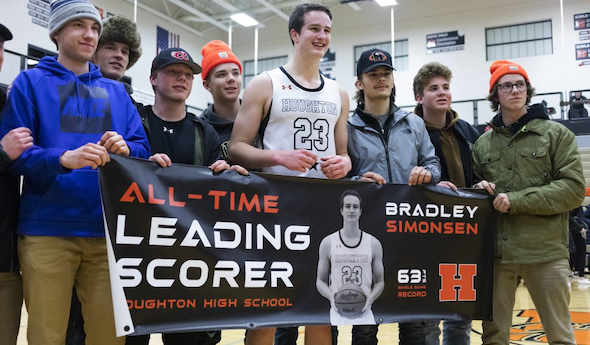
63-Pointer Stirs Memories of UP Legends
February 29, 2020
By Ron Pesch
Special for Second Half
For the first time since 1970 – 50 years ago – and for only the 10th time in Upper Peninsula boys basketball history, a player has scored 60 or more points in a single game.
And that Houghton showing has stoked memories of legendary U.P. scoring showcases going back more than a century.
For the first time, the effort was for naught, at least from a win-loss standpoint, as Houghton dropped a nonconference road contest to Ishpeming 88-83 on Feb. 4. Brad Simonsen hit 23 of 45 field goal attempts, including 7 of 18 from beyond the 3-point arc, as Houghton pushed the play, hoping to narrow what had been a 10-point halftime margin. The 6-foot-6 senior, signed by Michigan Tech, was 10 of 13 from the free throw line and scored 24 points in the fourth quarter, ending the night with 63.
The performance topped Houghton’s school record of 60 points, set by Gary Lange in 1970. The total ranks 14th across the entire state for single game points in a contest, and tied Simonsen for sixth highest above the bridge. There, the mark equaled the top single-game output posted by Stephenson’s Mel Peterson, considered by many the greatest cager ever to come out of the Upper Peninsula.
“Marvelous Mel”
Peterson was the son of a minister and one of 10 children (and eight boys). His older brother, George, broke the U.P. scoring record in 1949 with 44 points in a game for Stephenson High School. The family moved away from the Upper Peninsula following George’s graduation, ultimately landing in southeastern Idaho.
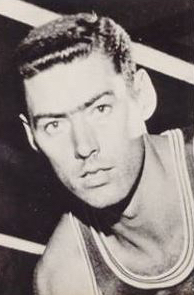 There, Mel emerged as an outstanding athlete for Idaho Falls High School. Standing 6-foot-4½, Peterson’s growth occurred mostly during his freshman year.
There, Mel emerged as an outstanding athlete for Idaho Falls High School. Standing 6-foot-4½, Peterson’s growth occurred mostly during his freshman year.
“I played quite a bit on the varsity my sophomore year,” recalled Peterson recently. “My junior year I started out very, very slow but ended up very good. (However,) I fractured my ankle with about a minute to go in the semifinals of the (1955) state tournament, which we won.”
Peterson led all scorers with 25 points and dominated the boards that night, but had to be helped from the floor, then didn’t play in the title contest. “We lost the state tournament by three points, (43-40 to Kellogg). I was a cheerleader. … It would have been fun to play in the final game.”
When his father received a call to serve the Mission Covenant Church in Wallace, Michigan, about seven miles south of Stephenson, the family returned to the Upper Peninsula for Peterson’s senior year.
“At that time, it was nothing like it is now, where you can find anything about anybody. Then, that wasn’t the case at all,” Peterson said. “So, when we came back, no one had any idea of where I lived before, if I played or not.”
Indeed, prior to football season, one newspaper report indicated Peterson had transferred in from North Dakota, while another listed him as coming from Illinois. Regardless, Peterson emerged as a solid football player at Stephenson High in the fall of 1955. But it was on the basketball court where his scoring and rebounding prowess quickly loomed. He opened the season with 33 points in a win over Gladstone, despite fouling out early in the fourth quarter.
By January, the media had taken to calling him “Marvelous Mel” as Peterson averaged 32.3 points in his first half-dozen games for the Eagles. He drove Stephenson to a 15-1 regular-season record, posting 11 games over 30 points and scoring more than 40 in six.
On Jan. 21, 1956, he poured in 63 points in an 89-44 win over Manistique, shattering his brother’s school record. Mel nailed 25 of 38 shots from the field and 13 of 16 from the free-throw line. At the time, the scoring total exceeded the previous known best in the U.P. of 60 points, scored by Norbert Purol in February 1952. (Purol, from Ironwood St. Ambrose, would later play two seasons of AAU ball in Chicago before matriculating at Kentucky Wesleyan, earning four letters between 1956 and 1959. Wesleyan ended the 1957 season as runner-up to Wheaton College in the inaugural NCAA Small College Tournament – now known as Division II.)
“I don’t remember a great deal about a lot of it. That was so long ago,” said Peterson, laughing. “I guess the thing I appreciate most about the game was that my coach (Duane “Gus” Lord), let me play the whole game, which didn’t happen real often. Probably the thing I remember most about the whole year is that we played a Catholic school, Lourdes, from Marinette, Wisconsin. The first game we played them we beat them 110 to 44. The second game we lost 68-66.”
Peterson’s regular-season total of 570 points also exceeded Purol’s U.P. record of 556 posted over 19 games in 1952. His regular-season average, which had climbed to 35.6, topped the previous best of 29.6, posted by Pete Kutches in 1952 for Escanaba St. Joseph. Then Peterson pushed the per-game-average even higher in the postseason.
Seeing more playing time in the playoffs, “Marvelous Mel,” notched more than 30 points in all seven postseason games (exceeding 40 in three of the contests and 50 once), leading Stephenson to the MHSAA Class B championship win against Detroit St. Andrews in sudden-death overtime, 73-71. There he scored the game-tying bucket with 17 seconds remaining in the three-minute extra frame, and then sunk the game winner 26 seconds into sudden death, where the first team to gain a two-point advantage was proclaimed the victor. That 1956 season saw three of the four basketball championships awarded to U.P. teams.
Peterson finished with 849 points on the year – at the time the best single-season performance in MHSAA history. He averaged 36.9 points across 23 contests – currently eighth in the MHSAA record book.
Following graduation, Peterson nearly signed to play at the University of Minnesota, but felt a better fit at Wheaton College, outside Chicago. There, he earned three All-American honors. As a freshman in 1957, he led Wheaton to victory in that first NCAA Small College Tournament championship game against Wesleyan, earning Most Outstanding Player honors along the way. Today, he remains Wheaton’s all-time leader in career points, points per game, field goals made and career rebounds, all accomplished “without the benefit of a 3-point line, which had yet to be implemented.”
Peterson, who helped the USA team win gold at the 1963 Pan American Games in Sao Paulo, Brazil, played two games for Baltimore in the National Basketball Association (NBA) before a heart condition sidetracked his career. Once the issue was repaired, he returned to play 134 games over three seasons in the American Basketball Association, earning an ABA league championship with the Oakland Oaks in 1969. In 2019, he was inducted into the Small College Basketball National Hall of Fame.
The High-Scoring Sixties
Roger Roell, a senior at Channing, topped Peterson’s U.P. single game record with a 67-point performance in early January 1960 by dropping 31 field goals and five free throws in a 105-55 win over Michigamme.
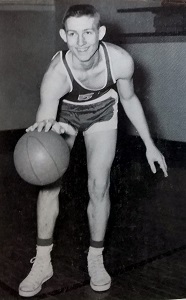 Just over seven weeks later, Jim Manning scored 69 for Trout Creek against Amasa in another lopsided affair, 140-47 (then, a U.P. record for highest team score. The team’s 44 points in the fourth quarter was also a U.P. mark at the time. Trout Creek’s coach, Bruce Warren began substituting in the second quarter).
Just over seven weeks later, Jim Manning scored 69 for Trout Creek against Amasa in another lopsided affair, 140-47 (then, a U.P. record for highest team score. The team’s 44 points in the fourth quarter was also a U.P. mark at the time. Trout Creek’s coach, Bruce Warren began substituting in the second quarter).
Manning, a junior, finished the 1959-60 season as the first player in U.P. history to exceed 600 points in one regular season, totaling 608 over 18 games. He would later pitch in the Major Leagues.
Roell finished second with 569 points in 18 regular-season contests. Third on the regular-season scoring list was another junior, Erwin Scholtz of Hermansville, who tallied 505 across 18 games.
As a senior, the 6-foot-5 Scholtz would post 71 points against Channing, a new benchmark for points in a game in the Upper Peninsula.
Or was it?
The Master’s Thesis
Perhaps because of the media coverage of Scholtz’s accomplishment, in 1962 the Crystal Falls Diamond Drill ran an article detailing the recently unearthed exploits of Ed Burling some 50 years prior. Richard Mettlach, football and baseball coach at Crystal Falls, had uncovered the Burling story.
Mettlach, “in the process of preparing a history of local high school sports which he submitted as a part of the preparation for his master’s degree … discovered that the newspaper records of the early years of high school basketball tell of a match between Iron River and Crystal Falls (played during the 1910-11 season).”
Crystal Falls had downed Iron River, 107-27, according to Mettlach’s research, and Burling had scored all but 10 of Crystal Falls’ points.
“Basketball was different in those days,” said Burling when interviewed by the Diamond Drill in January 1962. Then 68 years old and working as the postmaster in Crystal Falls, he recalled, “when one man was hitting the basket well, the rest of the team fed him the ball and let him shoot. I couldn’t miss that night.”
According to the article, “Burling said as he recalled the game, he made 98 points that night. It appears that 97, however, reportedly verified in two newspaper accounts of the game, will have to be the figure used in the record book.”
Burling recalled that the majority of his shots were from in front of the basket and that rules of the day allowed the top shooter on the team to attempt the free throws.
“The 97 point scoring record would probably have never been uncovered if it had not been for Mettlach’s research,” added the Diamond Drill.
Three more U.P. additions
In 1966, Bob Gale of Trout Creek scored 60 against Mercer, Wisconsin. Gale would later play at Michigan State.
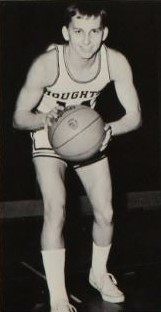 Houghton’s Lange scored his 60 as the Gremlins walloped Painsedale Jeffers, 134-62, on January 23, 1970. One week later, Larry Laitala dropped 65 as Champion crushed Felch, 114-71.
Houghton’s Lange scored his 60 as the Gremlins walloped Painsedale Jeffers, 134-62, on January 23, 1970. One week later, Larry Laitala dropped 65 as Champion crushed Felch, 114-71.
“We had a very good team that year. We had a lot of wings and normally, I wouldn’t play the whole game. My coach was Dominic Jacobetti (who played at Negaunee St. Paul, then Northern Michigan University) and he was a pretty prolific scorer in the U.P. It was one of those nights where the rim was real big,” recalled Laitala, chuckling.
Laitala finished second to Lange in regular-season scoring, 557 to 523, with each athlete playing 17 games.
“Houghton is possibly the best team in any class in the Upper Peninsula,” wrote Hal Schram in the Detroit Free Press, who predicted an MHSAA state title for the team noting that many felt Lange was the top player north of the bridge. The Gremlins, at 17-0, finished as the top-ranked team in Class C in the weekly press polls assembled by the Free Press, The Associated Press and United Press International.
But the season ended earlier than expected for both teams. Houghton fell to St. Ignace in a Regional Semifinal.
“We were beat by our archrival, Republic (61-55) in the first game of the (Class D) Districts, which was kind of an upset,” added Laitala.
Prior to Simonsen’s accomplishment, Lange and Laitala were the most recent players above the Straits of Mackinac to equal or exceed the 60-point minimum established in the MHSAA record book.
The Challenge of Traceability
With modern-day electronic archiving of a number of the state’s newspapers and the accessibility of newspapers on microfilm, an effort has been made to add dates to single-game records, where once only the season of accomplishment was listed. The work continues.
Today, more than 100 years later, the “two newspaper accounts” used back in the 1960s for verification of Burling’s scoring accomplishment have not resurfaced. Hence, neither the date of the game, nor details from period accounts are available for study. That, combined with knowledge that basketball games from the time were usually low-scoring affairs, means doubt is still cast on the mark.
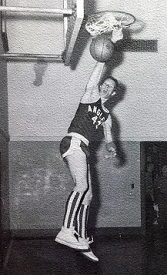 After investigation, the record was accepted by Crystal Falls historian Malcolm McNeil and U.P. sports archivist, Jim Trethewey, a former sports editor of the Marquette Mining Journal who travelled to Crystal Falls to interview Burling. MHSAA historian Dick Kishpaugh ultimately added the performance to the state record book. Questions about the legitimacy of Burling’s total began almost immediately and have resurfaced every 10 years or so. Todd Schulz, a former sports columnist at the Lansing State Journal, wrote extensively on the chase in 2012.
After investigation, the record was accepted by Crystal Falls historian Malcolm McNeil and U.P. sports archivist, Jim Trethewey, a former sports editor of the Marquette Mining Journal who travelled to Crystal Falls to interview Burling. MHSAA historian Dick Kishpaugh ultimately added the performance to the state record book. Questions about the legitimacy of Burling’s total began almost immediately and have resurfaced every 10 years or so. Todd Schulz, a former sports columnist at the Lansing State Journal, wrote extensively on the chase in 2012.
One of the individuals still working to help solve the mystery is Al Anderson of Crystal Falls.
The Diamond Drill was a weekly paper during Burling’s high school days, and newspapers of the time generally didn’t separate prep sporting news into sections. When reported upon, accounts of high school games were usually included in a ‘School Notes’ column.
The season was, without question, a success. “Winning eight out of ten games played, and having three challenges refused, the local basket ball team lay claim to the U.P. championship for the season of 1910-11,” stated the Diamond Drill in the March 25, 1911 edition.
Still, reports uncovered from the period publication continue to cast doubt on the plausibility of the feat occurring in a high school game. “… More basket ball and less indoor foot ball next time will look better to the audience,” noted the newspaper about a 17-10 victory over Niagara, Wis., in mid-December 1910.
“The basket ball game last night resulted in a dispute near the end of the last half with the score 13 to 12 in favor of Crystal Falls. Iron Mountain disputed a decision by the referee and withdrew from the floor,” was the account in the Feb. 18, 1911 edition of the paper.
“There’s an article that was cut out of the physical copy of the December 10, 1910 Diamond Drill,” reports Anderson, who’s been seeking confirmation in fits and starts for nearly a decade. “It looks like it could be the ‘School Notes.’ portion. It’s missing on microfiche copies as well. Perhaps that’s it.”
So the chase to verify continues.
2019-20 season brings sudden burst
Sophomore phenom Emoni Bates of Ypsilanti Lincoln is the latest prep player to etch his name in the MHSAA record book for scoring 63 points. He accomplished the feat in a 108-102 double-overtime win against Chelsea two weeks after Simonsen’s accomplishment. Statewide, that means 34 players have now scored 60 or more points in a game – 30 boys (10 in the U.P. and 20 in Lower Michigan) and four girls (one in the U.P and three in the Lower Peninsula).
Will the list be reduced by one? Time and additional research will tell.
 Ron Pesch has taken an active role in researching the history of MHSAA events since 1985 and began writing for MHSAA Finals programs in 1986, adding additional features and "flashbacks" in 1992. He inherited the title of MHSAA historian from the late Dick Kishpaugh following the 1993-94 school year, and resides in Muskegon. Contact him at [email protected] with ideas for historical articles.
Ron Pesch has taken an active role in researching the history of MHSAA events since 1985 and began writing for MHSAA Finals programs in 1986, adding additional features and "flashbacks" in 1992. He inherited the title of MHSAA historian from the late Dick Kishpaugh following the 1993-94 school year, and resides in Muskegon. Contact him at [email protected] with ideas for historical articles.
PHOTOS: (Top) Brad Simonsen celebrates becoming Houghton's all-time leading scorer Wednesday. (2) Stephenson's Mel Peterson. (3) Trout Creek's Jim Manning. (4) Houghton's Gary Lange. (5) Trout Creek's Bob Gale. (Top photo courtesy of Houghton Daily Mining Gazette. Peterson photo courtesy of Upper Peninsula Sports Hall of Fame. Houghton and Trout Creek photos courtesy of those schools' yearbook departments.)

